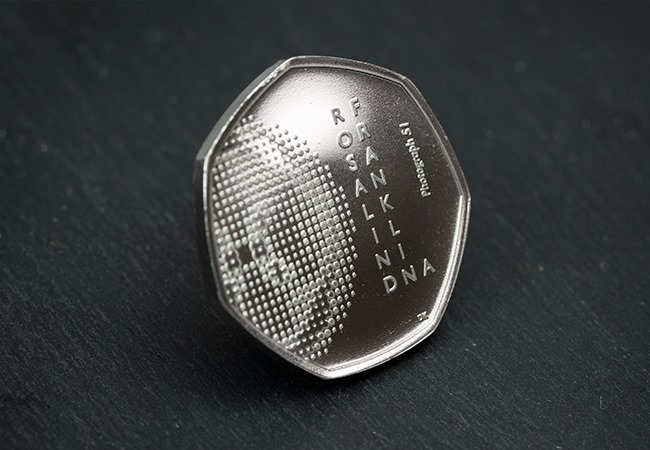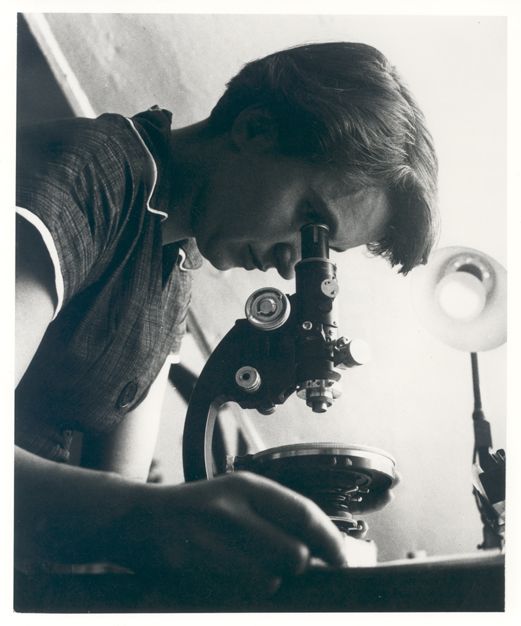Rosalind Franklin becomes the first female scientist celebrated on a UK coin!
In the year that would have marked her 100th birthday, The Royal Mint released a 50p celebrating the life and crucial work of Rosalind Franklin.

2020 UK Rosalind Franklin 50p
The striking design was created by David Knapton in collaboration with King’s College, London, and features a depiction of Rosalind Franklin’s X-ray, ‘Photograph 51’, which revealed the helical structure of DNA in her laboratory at King’s College, London in 1952.
Franklin’s name appears written vertically to the right, and cleverly, the abbreviation ‘DNA’ is written horizontally, tying in to the last two letters of her name.

This really is a coin full of numismatic firsts, as this was the first time that Franklin’s DNA story had featured on a UK coin, and it was also the very first time a female scientist had featured on a UK coin!
The Story Behind The Scientist
In 1869, Swiss chemist Friedrich Miescher isolated DNA from white blood cells and named it “nuclein”. The term “nuclein” was later changed to “nucleic acid” and then to “deoxyribonucleic acid”, what we now know as DNA.
83 years later, one of Britain’s greatest scientists, Rosalind Franklin made a crucial finding to the discovery of the double-helix structure of DNA, yet her contribution was little known.

Image credit: MRC Laboratory of Molecular Biology, CC BY-SA 4.0, via Wikimedia Commons.
Applying X-ray diffraction methods to the study of DNA enabled Franklin to discover the helical conformation of the molecule, in a photograph called, ‘Photograph 51’. This work laid the foundations for James Watson and Francis Crick to later establish that the structure of DNA was in fact a double-helix polymer (a spiral consisting of two DNA strands).

Image Credit: King’s College London Archives
Tragically, at the age of just 37, Franklin passed away from ovarian cancer, robbing her of the same awards and recognitions that her colleagues were gifted.
To mark what would have been a very special birthday, this 50p was issued to restore Franklin’s rightful legacy, and celebrates her significant role in the discovery of DNA.
The final discovery
In a Cambridge University laboratory in 1953, just 1 year after Franklin’s discovery, Francis Crick and James Watson found a twisted strand of deoxyribonucleic acid, intertwined in such a way that they could pull apart, replicate themselves, and pass their genetic code from old cells to new.
In 2003, to mark the 50th anniversary of Watson and Crick‘s discovery of the double-helix structure of DNA, The Royal Mint issued the DNA Double Helix £2.

As mentioned above, had Rosalind Franklin not discovered the helical conformation of DNA, Watson and Crick may never have established it’s double-helix structure!
The coin’s design, by John Mills, pays tribute to the ‘double-helix’ structure, with it spiralling across the coin and strands of chromosomes with the letter notations for the four main components of DNA. This coin has a circulating mintage of 4,299,000 and ranks as ‘less common’ on our Scarcity Index.
Other science themed UK coins
2019 Stephen Hawking 50p

In 2019, less than a year since his death, The Royal Mint released the Stephen Hawking 50p, honouring his works as one of the most influential physicists of the modern age.
He became the very first person to be celebrated in The Royal Mint’s Innovation in Science series and only the third person to be commemorated on a coin within a year of their death (the others being Winston Churchill and the Queen Mother!)
The reverse of the coin, designed by Edwina Ellis, features a stylised black hole and the inscription ‘Stephen Hawking’ . It also shows the Bekenstein-Hawking formula, which describes the thermodynamic entropy of a black hole!
2017 Isaac Newton 50p

Sir Isaac Newton is widely recognised as one of the most influential scientists of all time and a key figure in the scientific revolution. He changed our understanding of mathematics and physics, redefined the way we see the world and shaped the security of our currency in his role as Master of the Mint.
Designed by Aaron West, this 50p coin was issued to commemorate the achievements of Sir Isaac Newton and it remembers the legacy he left. It has a circulating mintage of just 1,801,500.
2009 Darwin £2

In 2009, The Royal Mint celebrated 200 years since Charles Darwin’s birth and 150 years since the publication of ‘On the Origin of Species’ by issuing this £2 coin. It has a circulating mintage of 3,903,000.
Darwin has been described as one of the most influential figures in human history and was known as the ‘father of evolution’. At the time of publication in 1859, his book was extremely controversial as it made it seem possible that humans evolved from apes, which contradicted the widely held Orthodox Church theory of creation!
2001 Wireless Transmission £2

In 1901, Guglielmo Marconi, an Italian physicist, succeeded in sending the first radio transmission across the Atlantic Ocean, disproving theories that the curvature of the earth would limit the transmission to 200 miles or less.
The message – simply containing the Morse code signal for the letter ‘s’ – travelled more than 2,000 miles from Poldhu in Cornwall to Newfoundland in Canada and won him worldwide fame and a Nobel Prize in physics in 1909.
In 2001, to celebrate the 100th anniversary of the first wireless transmission, The Royal Mint issued this £2 coin. It entered circulation and has a mintage of 4,558,000.
Do you have a favourite science themed UK coin? Let us know in the comments!

Download the Change Checker Web App for FREE to find, collect and swap your coins >>

Wooooww
The post is the same price as the coin ?
How do I know which new coins are going into circulation, and which are purely uncirculated, for collectors only ? As I am only interested in coins which have been in circulation…
Hi Davey,
This coin unfortunately will not be entering circulation. We will let Change Checkers know as soon as we hear of any coins entering circulation.
Thanks,
Alex